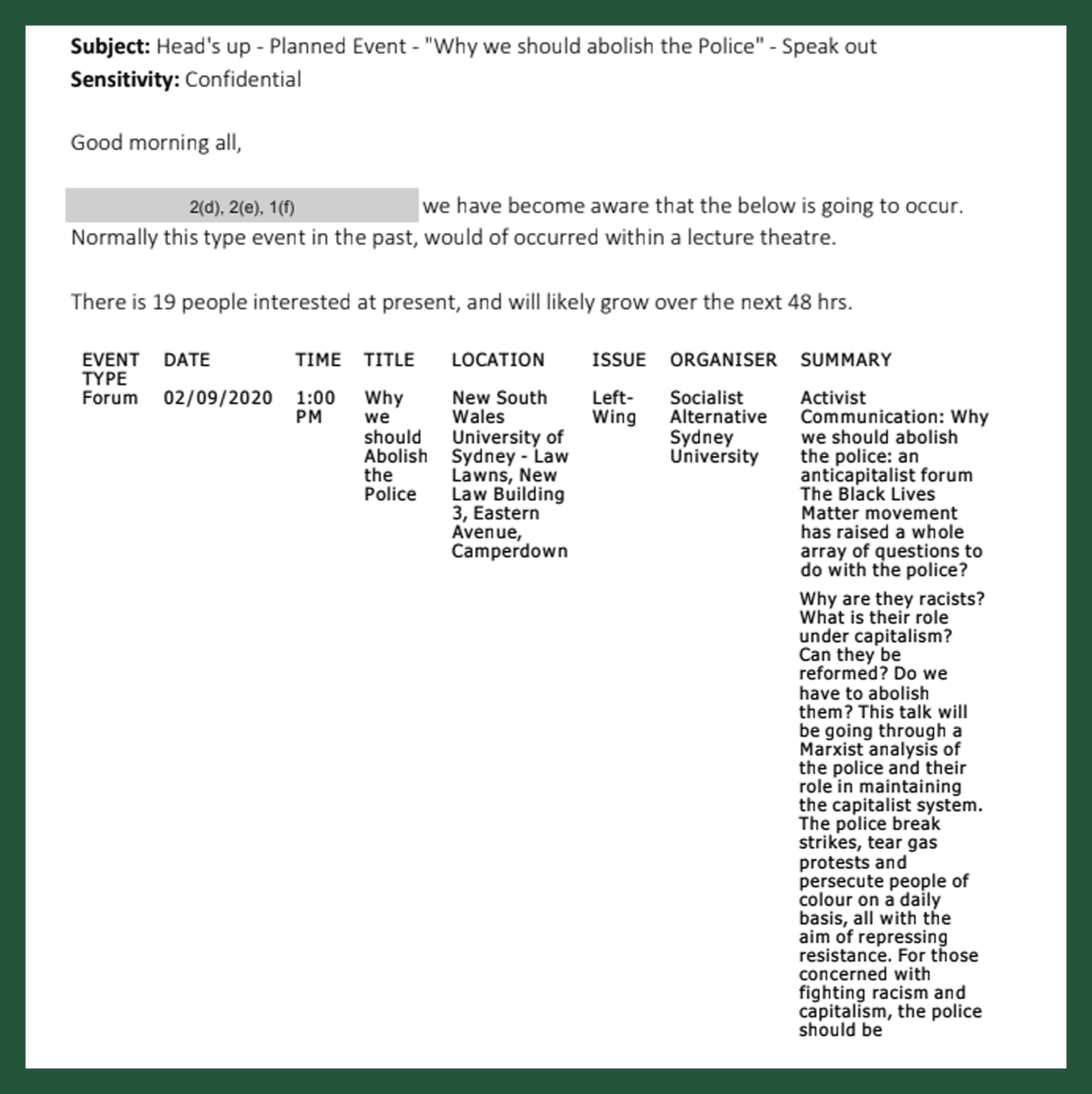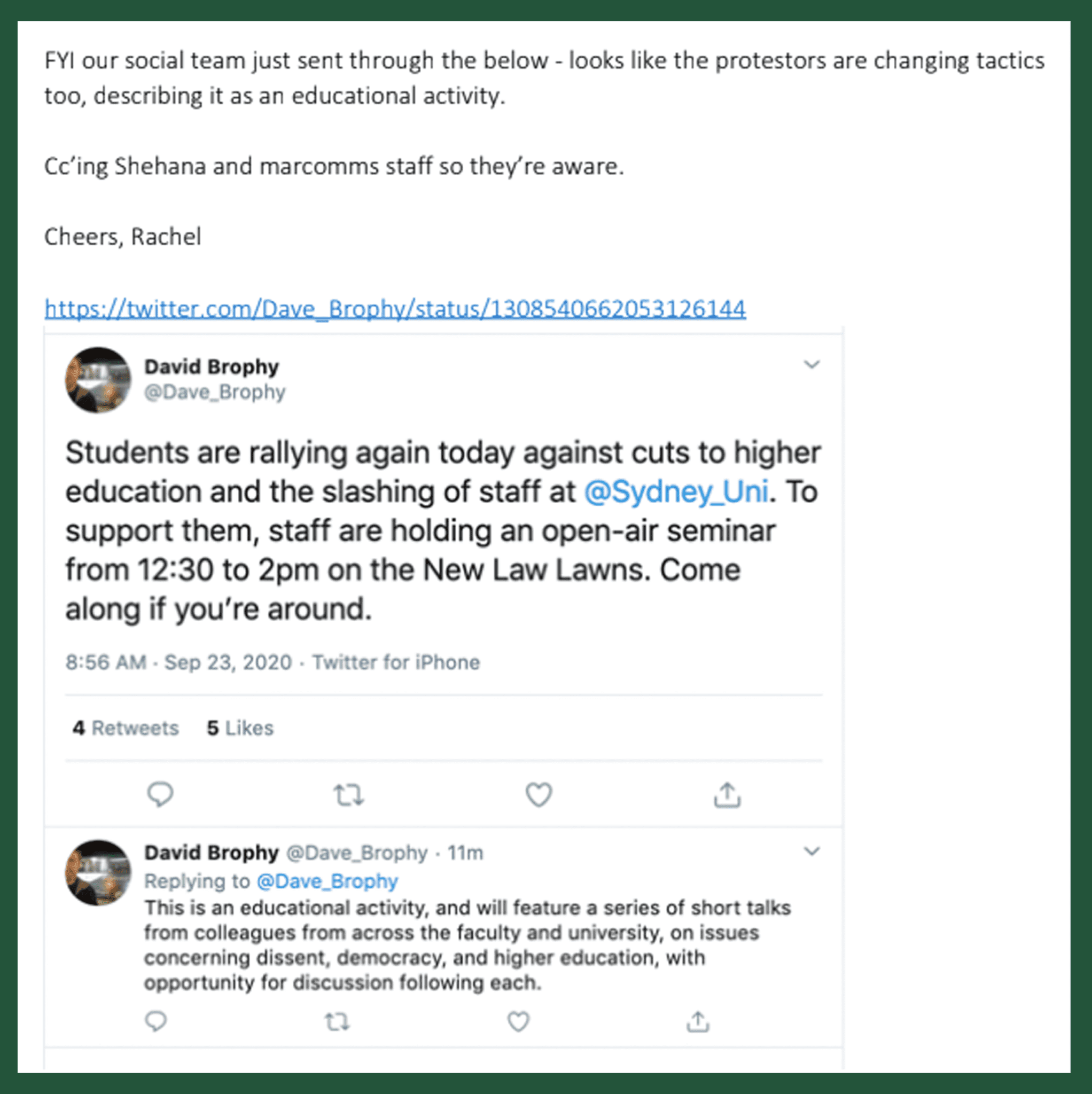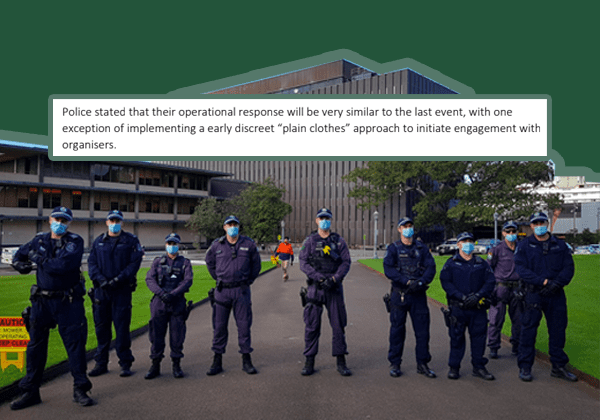The release of documents acquired under the Government Information (Public Access) Act 2009 (also known as GIPA) by the University of Sydney SRC’s Chair of Standing Legal Committee has shed new light on the conduct of police and the University during last year’s education protests.
Management aware of “plainclothes” officers on campus
2020 was a year marked by fervent staff and student protests against cuts made to courses, staff and funding. The released documents contain emails between members of University management, revealing that USyd Protective Services had been contacted by NSW Police to alert them of their presence in advance of several protests. According to emails from the Director of Asset Management and Operations Ben Hoyle, NSW Police deployed “plainclothes” officers to “initiate engagement” with the organisers of the 23 September ‘Day of Action.’ The University was made aware of the “plainclothes” officers ahead of the protest. Police were widely criticised last year for their excessive use of force and presence at education protests.
Security briefings of protests and surveillance of staff social media
The documents have revealed significant operations by University administration to track, background, and probe protest events on campus. Asset Management and Operations (AMO) prepared multiple briefings on upcoming protests listing predicted attendance, its political leaning, and its organisers. One briefing infographic simply described the event’s issue as “Left-Wing.” These briefings informed “risk reviews” of protests, which assessed the threat level of individual events.

AMO also attempted to identify links between organisers of the education protests and other political organisations. One of the briefs claimed that the Education Action Group was “very much aligned with Socialist Allianz [sic]”. It is unclear where this information has been sourced from.

Additionally, emails between members of University management featured screenshots of staff social media posts, including one tweet by Senior Lecturer in Modern Chinese History David Brophy, promoting an open-air seminar on the New Law Lawns in solidarity with students rallying against cuts to higher education on 23 September. Another email forwarded an NTEU communique about an upcoming protest that had been distributed to members by Branch President Kurt Iveson.

The culture of surveillance revealed in the documents extended beyond University management. In a partially-redacted email between Director Hoyle and members of University management regarding security engagement with NSW Police, Hoyle noted that “the event is publicly listed” but also cited “extensive intelligence networks” involved in the preparation for the protest.
Additionally, a number of emails shown in the documents reveal University administration’s use of Dataminr, an AI surveillance system that provides real-time alerts on targeted parameters. It was a Dataminr custom pulse that alerted University officials to a tweet by David Brophy regarding an outdoor teach-in. Whether the University established alerts for David Brophy or for NTEU announcements more broadly is unknown.
Building lockdowns “effective”
The use of building lockdowns, also described as “safe and secure mode,” to disrupt campus activism was mentioned throughout the extensive chain of emails. The transitioning of numerous buildings, such as Anderson Stuart and the Quadrangle, into safe and then secure mode not only disrupted the movements of protest participants but also the general student population. Director Hoyle described them as an “effective control” which “prevented further business disruption.”
Absence of university support for protests despite claims to support freedom of speech
On 23 September, the Executive Director of Central Operations Services Susan Turner wrote to Head of Protective Services and Emergency Management Sarah Holmes about two events that were scheduled to take place that day. One was an open-air educational seminar led by the Faculty of Arts and Social Sciences (FASS) and hence qualified as an “education seminar” that was “excluded from PHO [Public Health Order] restrictions.” In the email, Turner advised Holmes to make contact with the Police’s most Senior Official to inform them that only one event was exempt from police intervention.
In the same email, Turner emphasised that the role of Protective Services is not to engage with the police, though it would “be great if [Director Holmes] could support the academics involved by letting the Police know (as an FYI) when they arrive on campus (which I understand is imminent) that we have 2 very different events happening.” While Turner did attempt to pre-empt police intervention for the FASS led seminar, the emphasis was on ensuring that the “seminar” was not confused with the protest occurring on campus that day. There was no mention of how police might engage with the simultaneous protest, despite the documents showing awareness of police violence at a number of education protests.
The documents raise concerns about the University’s approach to student and staff safety. Despite “safe freedom of speech” arising in numerous management emails, there was an absence of practical measures from University management to support and protect the safety of students. This is unsurprising given the violent outcomes of a number of education protests last year.
Even more concerning is the extensive nature of surveillance of staff and student protests by the University and NSW Police, including the use of AI technology such as Dataminr to monitor search parameters or digital profiles as set out by University management. A significant portion of these surveillance measures remain unknown.





